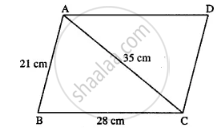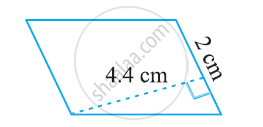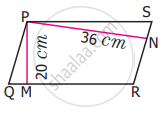Advertisements
Advertisements
प्रश्न
The adjacent sides of a parallelogram are 21 cm and 28 cm. If it's one diagonal is 35 cm; find the area of the parallelogram.
उत्तर

First, we find the area of ΔABC.
Sides are, a = 28 cm
b = 35 cm
and c = 21 cm
S = `(a + b + c)/2`
= `(28 + 35 + 21)/2`
= `84/2 = 42` cm
area of ΔABD = `sqrt(S(S - a)(S - b)(S - c))`
= `sqrt(42(42 - 28)(42 - 35)(42 - 21))`
= `sqrt(42 xx 14 xx 7 xx 21)`
= `sqrt(2 xx 21 xx 2 xx 7 xx 7 xx 21)`
= `sqrt(2 xx 2 xx 21 xx 21 xx 7 xx 7)`
= `2 xx 21 xx 7`
= 294 cm2
∵ Diagonal of ||gm divides it into two equal parts.
∴ area of ||gm = `2 xx "area of ΔABC"`
= 2 × 294
= 588 cm2
APPEARS IN
संबंधित प्रश्न
Find the area of the following parallelogram:

Find the area of the following parallelogram:

If base of a parallelogram is 18 cm and its height is 11 cm, find its area.
Area of a parallelogram is 83.2 sq cm. If its height is 6.4 cm, find the length of its base.
The area of parallelogram whose base 10 m and height 7 m is
A square and a parallelogram have the same area. If the side of the square is 48 m and the height of the parallelogram is 18 m. Find the length of the base of the parallelogram
In a parallelogram PQRS (See the diagram) PM and PN are the heights corresponding to the sides QR and RS respectively. If the area of the parallelogram is 900 sq.cm and the length of PM and PN are 20 cm and 36 cm respectively, find the length of the sides QR and SR
If the sides of a parallelogram are increased to twice its original lengths, how much will the perimeter of the new parallelogram?
To find area, any side of a parallelogram can be chosen as ______ of the parallelogram.
If perimeter of two parallelograms are equal, then their areas are also equal.
